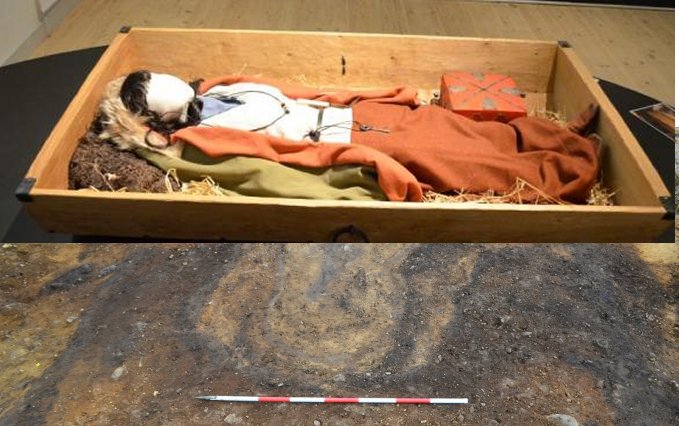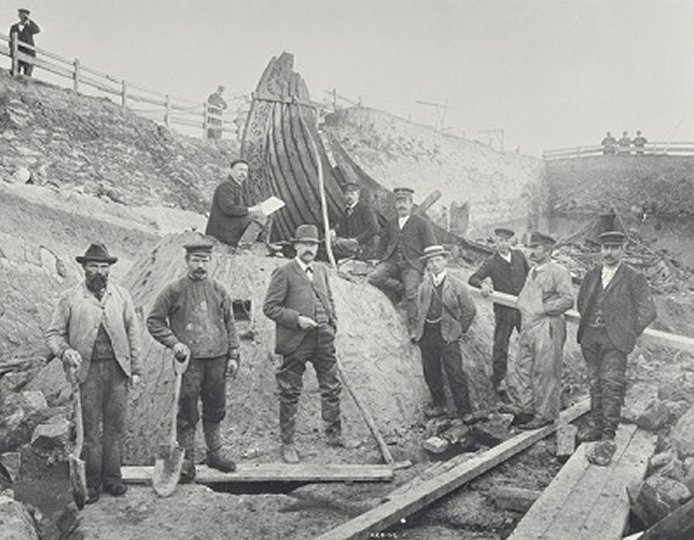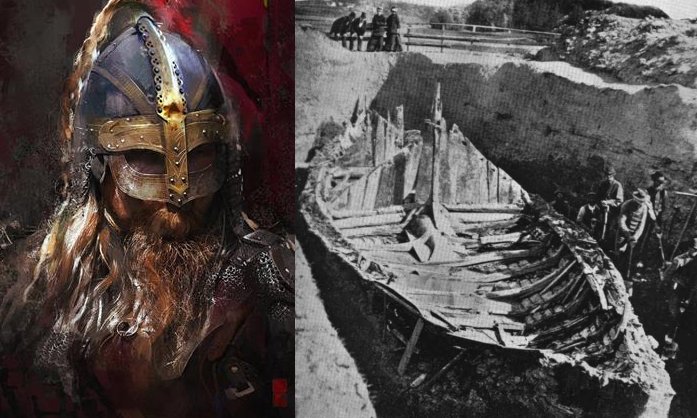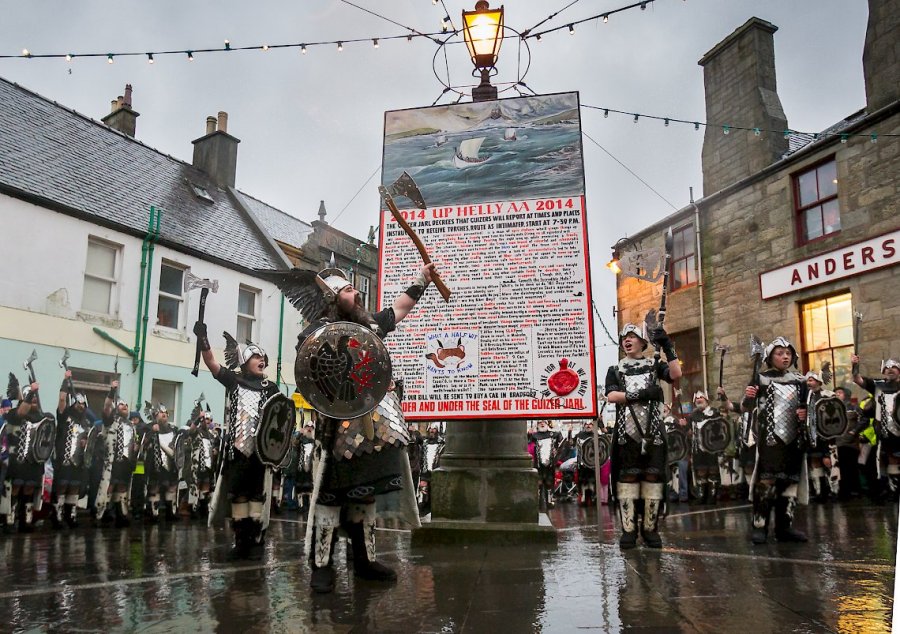Viking Funeral Traditions: Burning Ships, Complex Ancient Rituals And Incredible Up Helly Aa Festival
Ellen Lloyd - AncientPages.com - Ancient Viking funeral traditions and rituals were very complex. Before they adopted Christianity, Vikings were Pagans and had many customs, practices, and beliefs.
Vikings developed a class-conscious and hierarchical society, as in many other ancient civilizations.
Many relics in ancient tombs reveal that the type of burial a Viking received depended on his importance in the society. When a Viking died, he could either be buried or burned.
Vikings originated from present-day Denmark, Norway, and Sweden, and their burial customs depended on the region where they lived.
Vikings Were Burned Or Buried
Before the age of Christianity, when Vikings still worshipped pagan gods, it was common to bury a Viking with his belongings, often lying in a boat or a wagon to make the journey to the next world easier. People believed the deceased person would need particular objects in the afterlife.
Based on discovered archaeological evidence, it seems that the funeral boat or wagon was a practice that was reserved for the wealthy.
Viking Death House: Unique Tomb With Rare Remains Of Powerful Couple And Artifacts Discovered In Denmark
Most of the notable burial finds throughout the Viking world are cremations. Another option was that the Viking was burned, and cremation was relatively common during the early Viking Age. Ashes were later spread over the waters.
Ship Burial Was Reserved For Great Viking Warriors
A great Viking warrior received a ship burial. It involved placing the deceased on the ship, sailing it out to sea, and setting the Viking ship on fire.
This burial was not very common but rather reserved for sea captains, noble Vikings, and the very wealthy. In Old Norse times, proper boats took several months to construct and would not have been wasted without a reasonable cause or a suitable amount of status.
Several intriguing archaeological discoveries shed more light on ancient Viking burial customs. For example, one of the most important archaeological finds of the 20th on Orkney Island is the Scar Dragon Plaque, an artifact that testifies to the skills of the unknown Viking craftsman who made it. It was discovered at the site where archaeologists unearthed a Viking boat burial.
Excavation of Oseberg ship in 1904 - Photo: Museum of Cultural History (Photographer: Væring)
Although all wood of the boat had rotted away, the marks left in the sand by over 300 rusted iron rivets marked out the shape of the vessel that had carried its occupants to the Viking otherworld.
The discovery of the Gokstad Viking ship and the mysterious, unknown Viking Chief is exciting. The Gokstad ship was accidentally found by two curious young boys who began to dig into the mound to see if they could find anything interesting.
It caused a sensation in Norway. Onboard the ship was a dead man. He was fully dressed and surrounded by ancient artifacts such as a bronze kettle, runic inscriptions, a game board, and a sleigh. It soon became apparent that, about 900 A.D., a rich and powerful man died, and the Gokstad ship was used for his burial.
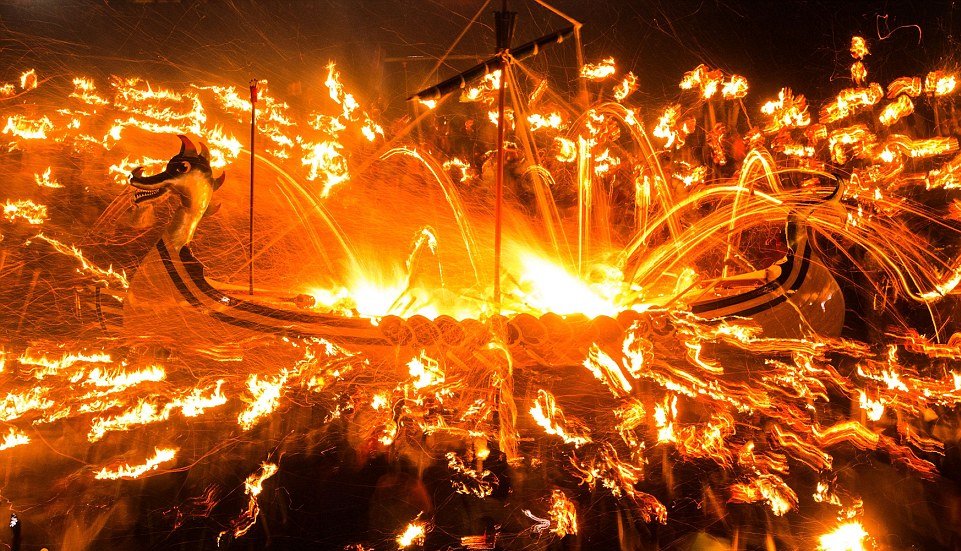 You can experience a Viking Ship burial in modern times.
You can experience a Viking Ship burial in modern times.
Incredible Up Helly Aa Festival – Experience A Viking Ship Burial In Modern Times
During the Up Helly Aa festival in Lerwick, Shetland Islands, one can experience the sacrifice of a longship. The annual festival began in 1870. It celebrates the influence of the Scandinavian Vikings in the Shetland Islands. The Norse ruled Shetland and neighboring island Orkney for about 500 years until they became part of Scotland in 1468.
Up Helly Aa is an incredible and unforgettable experience. Several thousand people work the whole year to organize this fantastic event on the last Tuesday of January each year.
People from all across the world come to the Shetland Islands to see this celebration. Hundreds of people dressed as Vikings march through the town in the wind and rain.
They work together to recreate the ancient past, in a tradition that dates back to the 1880s.
Viking Burial Customs Changed When Christianity Took Over
Around the year 1,000, Christianity started to take over as the main religion of the Vikings. Some Scandinavian countries accepted Christianity fast. By the mid-11th century, Christianity was well-established in Denmark and most of Norway.
Up Helly Aa Festival takes place every year on the last Tuesday of January. Credit: Shetland.org
It took longer for Sweden to convert entirely to Christianity. A temporary conversion took place in the early 11th century, but Christianity was finally established in Sweden in the mid-12th century.
As a result of the Vikings’ conversion to Christianity, burial practices changed. Cremation was no longer practiced as often, and inhumation was more widely adopted.
Written by Ellen Lloyd – AncientPages.com
Updated on November 13, 2022
Copyright © AncientPages.com All rights reserved. This material may not be published, broadcast, rewritten or redistributed in whole or part without the express written permission of AncientPages.com
Expand for referencesMore From Ancient Pages
-
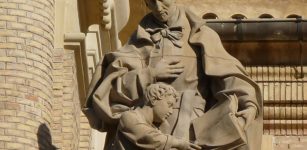 On This Day In History: First Public And Free School Opened For Poor Children – On Sep 15, 1616
News | Sep 15, 2016
On This Day In History: First Public And Free School Opened For Poor Children – On Sep 15, 1616
News | Sep 15, 2016 -
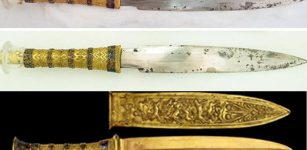 King Tut’s Cosmic Dagger Was Not Made In Egypt – New Study Reveals
Archaeology | Feb 24, 2022
King Tut’s Cosmic Dagger Was Not Made In Egypt – New Study Reveals
Archaeology | Feb 24, 2022 -
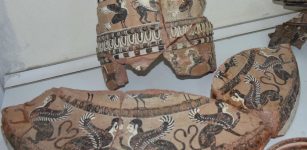 One Of A Kind 2,500-Year-Old Ritual Wash Basin Painted With Mythological Figures Discovered In The Ancient City Of Klazomenai
Archaeology | Oct 1, 2022
One Of A Kind 2,500-Year-Old Ritual Wash Basin Painted With Mythological Figures Discovered In The Ancient City Of Klazomenai
Archaeology | Oct 1, 2022 -
 Spectacular Statue Of Sea God Triton Found In Roman Mausoleum In Kent
Archaeology | Sep 13, 2023
Spectacular Statue Of Sea God Triton Found In Roman Mausoleum In Kent
Archaeology | Sep 13, 2023 -
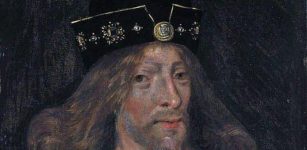 On This Day In History: King James I Of Scotland Was Assassinated – On Feb 21, 1437
News | Feb 21, 2017
On This Day In History: King James I Of Scotland Was Assassinated – On Feb 21, 1437
News | Feb 21, 2017 -
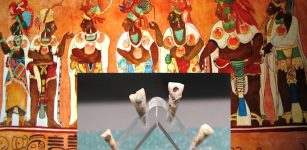 Ancient Maya Used An Unknown And Ingenious Method To Prevent Tooth Decay And Infections – Scientists Say
Archaeology | May 24, 2022
Ancient Maya Used An Unknown And Ingenious Method To Prevent Tooth Decay And Infections – Scientists Say
Archaeology | May 24, 2022 -
 Stunning 2,400-Year-Old Mask Of God Dionysus Unearthed In Ancient City Of Daskyleion
Archaeology | Sep 7, 2020
Stunning 2,400-Year-Old Mask Of God Dionysus Unearthed In Ancient City Of Daskyleion
Archaeology | Sep 7, 2020 -
 Ancient Recycling Technology Modern World Still Hasn’t Invented
Civilizations | May 5, 2018
Ancient Recycling Technology Modern World Still Hasn’t Invented
Civilizations | May 5, 2018 -
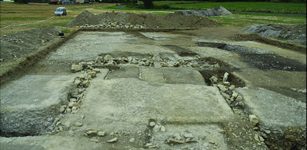 Stone Homes Of Europe’s First Megalithic Builders Discovered
Archaeology | Feb 22, 2023
Stone Homes Of Europe’s First Megalithic Builders Discovered
Archaeology | Feb 22, 2023 -
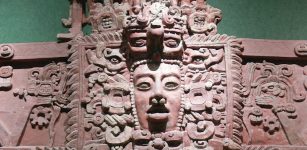 Ancient Maya Lessons On Surviving Drought – Examined By Scientists
Archaeology | Jan 5, 2022
Ancient Maya Lessons On Surviving Drought – Examined By Scientists
Archaeology | Jan 5, 2022 -
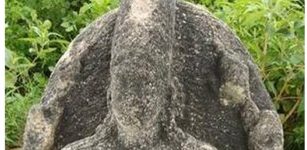 8th Century Sculpture Of Lord Vishnu Belonging To Pandya Dynasty – Unearthed
Archaeology | Sep 16, 2020
8th Century Sculpture Of Lord Vishnu Belonging To Pandya Dynasty – Unearthed
Archaeology | Sep 16, 2020 -
 The Opening Of Pandora’s Box May Have Been A Real Event
Featured Stories | Jun 22, 2021
The Opening Of Pandora’s Box May Have Been A Real Event
Featured Stories | Jun 22, 2021 -
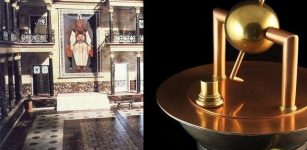 Incredible Ancient Machines Invented By Hero Of Alexandria – An Engineer Far Ahead Of His Time
Featured Stories | Jun 3, 2020
Incredible Ancient Machines Invented By Hero Of Alexandria – An Engineer Far Ahead Of His Time
Featured Stories | Jun 3, 2020 -
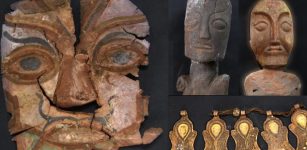 Golden And Silver Facial Ornaments, Wooden Figurines Among The Finds In Tomb Of Tibetan Plateau
Archaeology | Dec 28, 2020
Golden And Silver Facial Ornaments, Wooden Figurines Among The Finds In Tomb Of Tibetan Plateau
Archaeology | Dec 28, 2020 -
 Four Roman-Era Brooches And A Ring Found In The Borki Forest, Poland
Archaeology | Mar 15, 2024
Four Roman-Era Brooches And A Ring Found In The Borki Forest, Poland
Archaeology | Mar 15, 2024 -
 Who Or What Made These Mysterious Holes At The Bottom Of The Atlantic Ocean?
News | Mar 23, 2023
Who Or What Made These Mysterious Holes At The Bottom Of The Atlantic Ocean?
News | Mar 23, 2023 -
 New Theory On “Dry Moat” At The Pyramid Of Pharaoh Djoser
Archaeology | Jul 3, 2019
New Theory On “Dry Moat” At The Pyramid Of Pharaoh Djoser
Archaeology | Jul 3, 2019 -
 When Did Humans Start Using Roads And What Civilization Built The First Paved Roads?
Archaeology | Oct 26, 2022
When Did Humans Start Using Roads And What Civilization Built The First Paved Roads?
Archaeology | Oct 26, 2022 -
 Ancient Tomb Belonging To Princess Of Ancient Nomads Discovered In China
Archaeology | Dec 20, 2015
Ancient Tomb Belonging To Princess Of Ancient Nomads Discovered In China
Archaeology | Dec 20, 2015 -
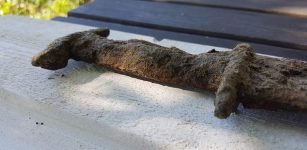 Viking Era Sword Discovered By Young Girl
Archaeology | Oct 5, 2018
Viking Era Sword Discovered By Young Girl
Archaeology | Oct 5, 2018


